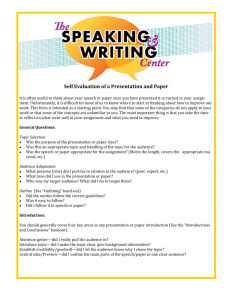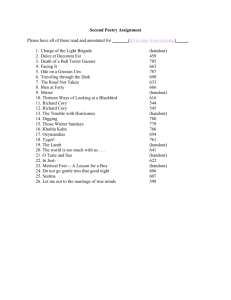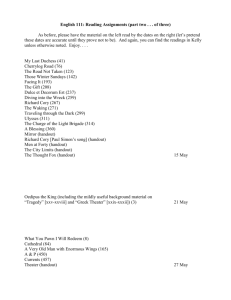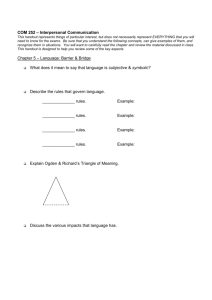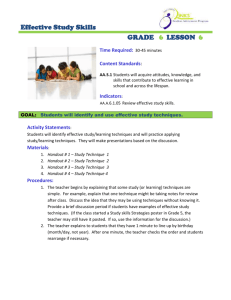WHAT IS CULTURE? Grade Levels
advertisement
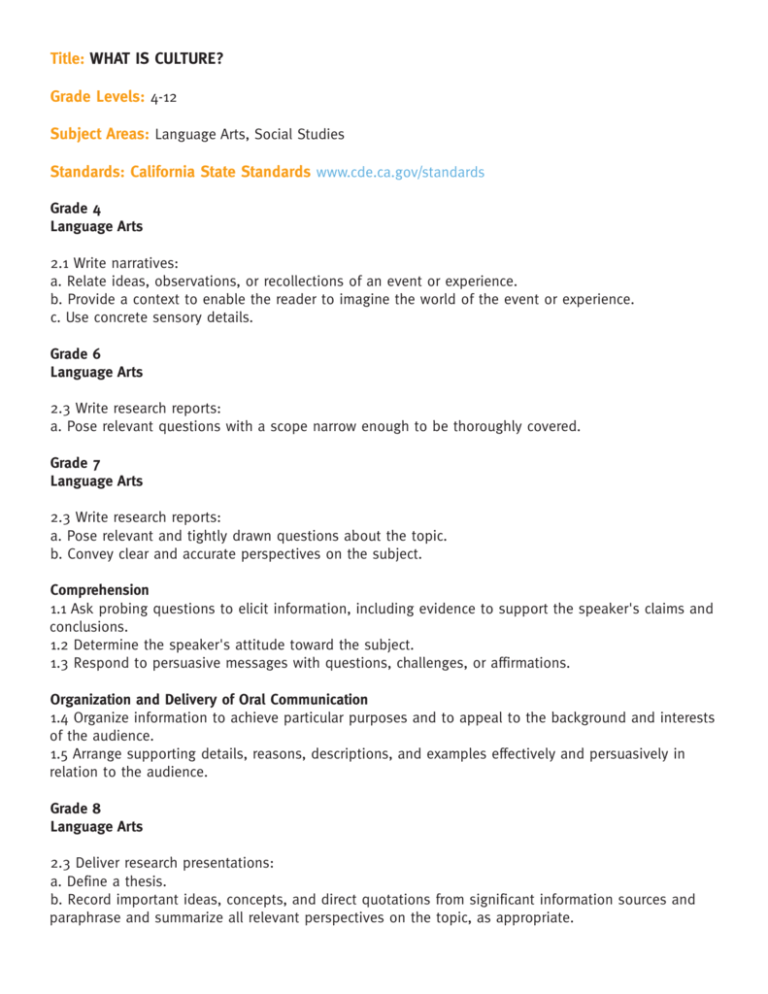
Title: WHAT IS CULTURE? Grade Levels: 4-12 Subject Areas: Language Arts, Social Studies Standards: California State Standards www.cde.ca.gov/standards Grade 4 Language Arts 2.1 Write narratives: a. Relate ideas, observations, or recollections of an event or experience. b. Provide a context to enable the reader to imagine the world of the event or experience. c. Use concrete sensory details. Grade 6 Language Arts 2.3 Write research reports: a. Pose relevant questions with a scope narrow enough to be thoroughly covered. Grade 7 Language Arts 2.3 Write research reports: a. Pose relevant and tightly drawn questions about the topic. b. Convey clear and accurate perspectives on the subject. Comprehension 1.1 Ask probing questions to elicit information, including evidence to support the speaker's claims and conclusions. 1.2 Determine the speaker's attitude toward the subject. 1.3 Respond to persuasive messages with questions, challenges, or affirmations. Organization and Delivery of Oral Communication 1.4 Organize information to achieve particular purposes and to appeal to the background and interests of the audience. 1.5 Arrange supporting details, reasons, descriptions, and examples effectively and persuasively in relation to the audience. Grade 8 Language Arts 2.3 Deliver research presentations: a. Define a thesis. b. Record important ideas, concepts, and direct quotations from significant information sources and paraphrase and summarize all relevant perspectives on the topic, as appropriate. c. Use a variety of primary and secondary sources and distinguish the nature and value of each. d. Organize and record information on charts, maps, and graphs. Grades 9 and 10 Language Arts 2.6 Deliver descriptive presentations: a. Establish clearly the speaker's point of view on the subject of the presentation. b. Establish clearly the speaker's relationship with that subject (e.g., dispassionate observation, personal involvement). c. Use effective, factual descriptions of appearance, concrete images, shifting perspectives and vantage points, and sensory details. Learning Objectives: Students will ∑ • observe customs and behaviors. ∑ • develop awareness of groups they identify with. ∑ • learn about themselves and other students in their class. Time: Three to four 40- to 50-minute class periods Materials: Addendum for teacher reference -- Aspects of Culture Handouts for students: ∑ • Handout 1 -- Culture Flower ∑ • Handout 2 -- Culture Flower Debriefing Questions ∑ • Handout 3 -- Classroom Culture Observation Form ∑ • Handout 4 -- Family Culture Observation Form Activity One: What Is Culture? 1. Ask students what they think culture is. Record their ideas on a large sheet of paper. Use the Addendum “Aspects of Culture” to spur additional ideas. 2. Give students the Definition of Culture and then solicit additional ideas for the brainstorm list. Definition of Culture Culture consists of all the different things that identify you and where you come from. These include race, ethnicity, religion, country or city, languages, age and financial status. Culture means all these things -- all the ways people live together and define themselves. We each participate in family, community, economic, linguistic and religious cultures based on who we are and the people with whom we associate. Culture is learned and transmitted from one generation to another. Children learn their culture from their families and their various communities. 1. Ask students what they think culture is. Record their ideas on a large sheet of paper. Use the Addendum “Aspects of Culture” to spur additional ideas. 2. Give students the Definition of Culture and then solicit additional ideas for the brainstorm list. Definition of Culture Culture consists of all the different things that identify you and where you come from. These include race, ethnicity, religion, country or city, languages, age and financial status. Culture means all these things -- all the ways people live together and define themselves. We each participate in family, community, economic, linguistic and religious cultures based on who we are and the people with whom we associate. Culture is learned and transmitted from one generation to another. Children learn their culture from their families and their various communities. Activity Two: Observe Classroom Culture The purpose of this activity is to help students become observers of their own classroom culture. 1. For homework, have students complete the Classroom Culture Observation Form (Handout 3). Talk with them about the things on which they might report. Some questions to start with are on the handout. An option is to report on the culture of the school instead of the culture of the classroom. Stress the importance of an attitude of curiosity and a heightened attention to details that we automatically ignore in our day-to-day lives. 2. List the students’ observations on the board or a large piece of paper. 3. Point out similarities and differences in their observations and discuss possible reasons for the differences. Activity Three: Observe Family Culture The purpose of this activity is to help students become observers of their family cultures. 1. Have students write out a report answering the questions on Handout 4 in an interesting storytelling fashion. Encourage them to attach family photos if available. 2. Students can make their reports into books or photo albums to be posted around the room or placed in a display case. The reports can also be shared with family members during Open House. Extension Activity: Autobiographical Art Project or Family History Books 1. Have students make small handmade books including photos (or copies of photos) and other memorabilia relating to their family tree, stories about their ancestors’ youth and/or conditions for immigrants to this country. Handout 1 Culture Flower Handout 2 Culture Flower Debriefing Questions Show your partner or the members of your discussion group the information you have entered on your Culture Flower and tell them a little something about each petal. Then, answer the following questions: 1. Which petal on the flower do you identify with most strongly? 2. What do you appreciate most about this group or cultural aspect? What do you least appreciate about this group or cultural aspect? 3. What incorrect assumptions or stereotypes do people make about your group or chosen cultural aspect? 4. Pick the groups from two petals that are the most different from each other. Discuss the ways you have to change your behavior when switching between these groups. For example, if you speak one language at home and another at school, does it take you a few minutes to get comfortable after switching languages? Handout 3 Observing the culture of the classroom For this activity, you will become a researcher collecting information to help visitng foreign students adapt to your school and class. You will have to observe and document how your class or school operates. To help you get started, try to think of the kinds of things you would want to know if you were starting school in another country. Some broad questions you should try to answer are the following: • What do we do? • Why do we do what we do? • How do we feel about what we do? As a reseacher, you should record what you see and hear happening. You should also talk with other students regarding their feelings about what happens in the class. Think about how some of the following things are done in the classroom: How does each day begins? What are the standards of behavior (rules, and so forth?) How and when do students work together in groups? What projects are done in class? How much homework is required? How and when students work individually? How is student seating assigned? How are students expected to treat one another? How does the school day end? What other activities and procedures occur throughout the day or class period? Observe one of the activities or routines of the classroom and document it in detail. Handout 4 Family Culture Observation Form Family Members Birth Communications Shelter Religion/Beliefs/Rituals Holidays Economics/Jobs Clothing Food Recreation Household Politics Art Who lives in your family? Where were you born? Your parents? Grandparents? What language(s) do you speak at home? What language(s) do your parents/grandparents speak? What is your home like? What religion, if any, do you practice? What religious beliefs do you have? Do you go to a special place to observe religious holidays? How else do you show your religious beliefs? What holidays do you celebrate? How do you celebrate each holiday? What jobs do people in your family do at home? What jobs do people in your family do outside the home? What kinds of clothes do the members of your family wear? What kinds of clothes do members of your family wear for special occasions or religious holidays? How or where do you get non-Western clothes, if you wear them? What foods do you eat at home? What foods did your parents eat as children? What activities do your family members participate in together? Who makes the decisions in your house? How are decisions made? What power does each person have, if any? What kind of art or decoration is there around your house, if any? What arts do people in your family practice (for example, music, painting, dance)? Addendum -- Aspects of Culture Culture is… Customs Beliefs Way of Life How People Live Religion Ethnicity/Race Language Gender Age group Sports Membership in clubs and other groups Hobbies City/State/Country Sexual Preference Holidays Material Goods Traditions Food/Drink/Eating Customs Immigration Calendar Agriculture Dress Rites of Passage Rituals Transportation Written Information (for example, books, sacred texts) Unwritten Information (for example, sayings, stories, jokes) Family Unit Economy/Money Education Entertainment (for example, music) Art




